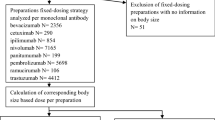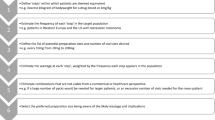Abstract
Background Manual compounding of expensive cytotoxic drugs often leads to drug wastage, due to residual product in vials not being used. Aim To determine the cost savings that can be achieved by implementing an automated compounding process with a vial sharing strategy, instead of manually compounding drugs. Method The drug wastage during automated compounding was compared with that of three simulation scenarios using manual compounding, in a general teaching hospital. All automatically compounded preparations of rituximab, pemetrexed, bevacizumab, and trastuzumab from September 2019 and up until February 2020 were included. A vial sharing strategy was implemented during the automated compounding process (scenario 1). In this scenario, all residual drugs could be reused for up to seven days. Two of the simulation scenarios for manual compounding were executed using a batch compounding strategy, for an entire working day (scenario 2), and twice a day (scenario 3). The third manual compounding simulation was executed without making use of a batch compounding strategy (scenario 4). Results There was no drug wastage during automated compounding with vial sharing (scenario 1). The cost of drug wastage for 1001 preparations, over a period of six months for rituximab, pemetrexed, bevacizumab, and trastuzumab combined, were € 34,133 for scenario 2, € 46,688 for scenario 3, and € 88,255 for scenario 4. The estimated total cost savings between 2017, when the compounding robot was commissioned, and 2021, was more than € 280,000. Conclusion Vial sharing of expensive drugs during automated compounding can prevent drug wastage, resulting in an economic and environmental advantage as opposed to manual compounding.

Similar content being viewed by others
References
Elkin EB, Bach PB. Cancer’s next frontier: addressing high and increasing costs. JAMA. 2010;303:1086–7.
Caplan AL. Will evidence ever be sufficient to resolve the challenge of cost containment? J Clin Oncol. 2011;29:1946–8.
Eudralex GMP, Annex 1. Manufacture of sterile medicinal products. 2008. https://ec.europa.eu/health/documents/eudralex/vol-4. Accessed 5 Jul 2021.
Fasola G, Aprile G, Marini L, et al. Drug waste minimization as an effective strategy of cost-containment in oncology. BMC Health Serv Res. 2014;14:57.
De Graaf H, Haisma JA. Verworpen vials. Med Contact (Bussum). 2006;61:748–50.
Au YS, Knoester P. Spillage dure medicatie kan drastisch minder. Maatregelen maken forse besparingen mogelijk. Pharm Weekbl. 2011.
Winger BJ, Clements EA, DeYoung JL, et al. Cost savings from dose rounding of biologic anticancer agents in adults. J Oncol Pharm Pract. 2011;17:246–51.
Patel S, Le A. Rounding rituximab dose to nearest vial size. J Oncol Pharm Pract. 2013;19:218–21.
Francis SM, Heyliger A, Miyares MA, et al. Potential cost savings associated with dose rounding antineoplastic monoclonal agents. J Oncol Pharm Pract. 2015;21:280–4.
Lindsey S, Parsons LB, Figg LR, et al. Evaluation of the dosing strategies of biologic agents and the theoretical impact of dose rounding. J Oncol Pharm Pract. 2018;24:47–55.
Afanasjeva J, Gruenberg K. Pharmacists as environmental stewards: Strategies for minimizing and managing drug waste. Sustain Chem Pharm. 2019;13:100164.
Smale EM, Egberts TCG, Heerdink ER, et al. Waste-minimising measures to achieve sustainable supply and use of medication. Sustain Chem Pharm. 2021;20:100400.
Fasola G, Aita M, Marini L, et al. Drug waste minimisation and cost-containment in Medical Oncology: two-year results of a feasibility study. BMC Health Serv Res. 2008;8:70.
Batson S, Mitchell SA, Lau D, et al. Automated compounding technology and workflow solutions for the preparation of chemotherapy: a systematic review. Eur J Hosp Pharm. 2020;27:330–6.
Werumeus Buning A, Geersing TH, Crul M. The assessment of environmental and external cross-contamination in preparing ready-to-administer cytotoxic drugs: a comparison between a robotic system and conventional manual production. Int J Pharm Pract. 2020;28:66–74.
Geersing TH, Klous MG, Franssen EJF, et al. Robotic compounding versus manual compounding of chemotherapy: comparing dosing accuracy and precision. Eur J Pharm Sci. 2020;155:105536.
Masini C, Nanni O, Antaridi S, et al. Automated preparation of chemotherapy: quality improvement and economic sustainability. Am J Health Syst Pharm. 2014;71:579–85.
Geersing TH, Franssen EJF, Pilesi F, et al. Microbiological performance of a robotic system for aseptic compounding of cytostatic drugs. Eur J Pharm Sci. 2019;130:181–5.
Besheer A, Mahler HC, Matter-Schwald A, et al. Evaluation of different quality-relevant aspects of closed system transfer devices (CSTDs). Pharm Res. 2020;37:81.
Sreedhara A, Zamiri C, Goswami S, et al. Challenges of using closed system transfer devices with biological drug products: an industry perspective. J Pharm Sci. 2020;109:22–9.
Respaud R, Tournamille JF, Saintenoy G, et al. Computer-assisted management of unconsumed drugs as a cost-containment strategy in oncology. Int J Clin Pharm. 2014;36:892–5.
Edwards MS, Solimando DA, Grollman FR, et al. Cost savings realized by use of the PhaSeal(®) closed-system transfer device for preparation of antineoplastic agents. J Oncol Pharm Pract. 2013;19:338–47.
Siderov J. Utility of PhaSeal, a closed-system drug transfer device, in facilitating vial sharing to reduce waste and assist in medication cost savings. J Pharm Pract Res. 2019;49:421–5.
Hess LM, Cui ZL, Li XI, et al. Drug wastage and costs to the healthcare system in the care of patients with non-small cell lung cancer in the United States. J Med Econ. 2018;21:755–61.
Liran O, Prus J, Gordon N, et al. A real-world analysis of cancer drug wastage due to oversized vials. J Am Pharm Assoc. 2018;58:643–6.
Gopisankar MG, Wahlang J, Jagtap V, et al. Cancer chemotherapy drug wastage in a tertiary care hospital in India-A 3-month prospective and 1-year retrospective study. Br J Clin Pharmacol. 2019;85:2428–35.
Smith R. A 2-year retrospective review of vial sharing options for the compounding of cytotoxics. Eur J Hosp Pharm. 2015;22:161–4.
Goldstein DA, Clark J, Tu Y, et al. A global comparison of the cost of patented cancer drugs in relation to global differences in wealth. Oncotarget. 2017;8:71548–55.
Acknowledgements
We would like to acknowledge Prof. Dr. Catherijne Knibbe for reading the manuscript critically. We also remember and thank the late prof. Dr. Wim Jiskoot for his feedback while writing the manuscript.
Funding
The authors did not receive support from any organization for the submitted work.
Author information
Authors and Affiliations
Corresponding author
Ethics declarations
Conflicts of interest
The authors have no conflicts of interest to declare.
Additional information
Publisher’s Note
Springer Nature remains neutral with regard to jurisdictional claims in published maps and institutional affiliations.
Rights and permissions
About this article
Cite this article
Baan, S.D., Geersing, T.H., Crul, M. et al. An economic evaluation of vial sharing of expensive drugs in automated compounding. Int J Clin Pharm 44, 673–679 (2022). https://doi.org/10.1007/s11096-022-01388-6
Received:
Accepted:
Published:
Issue Date:
DOI: https://doi.org/10.1007/s11096-022-01388-6




